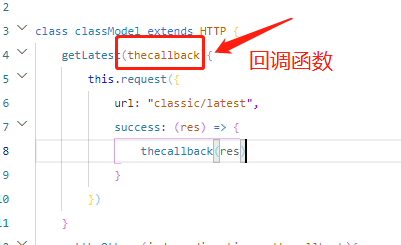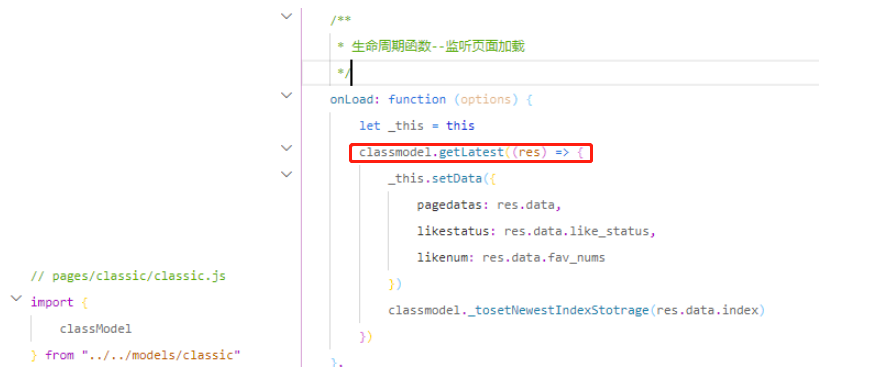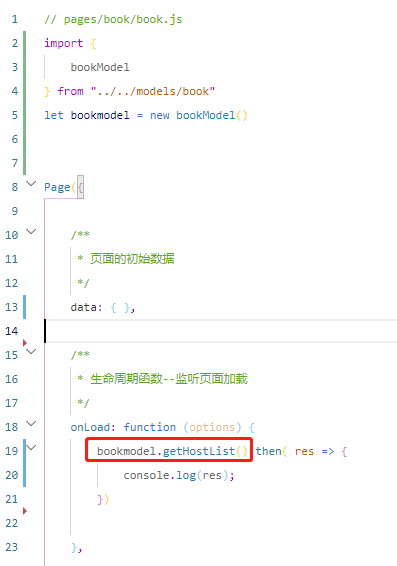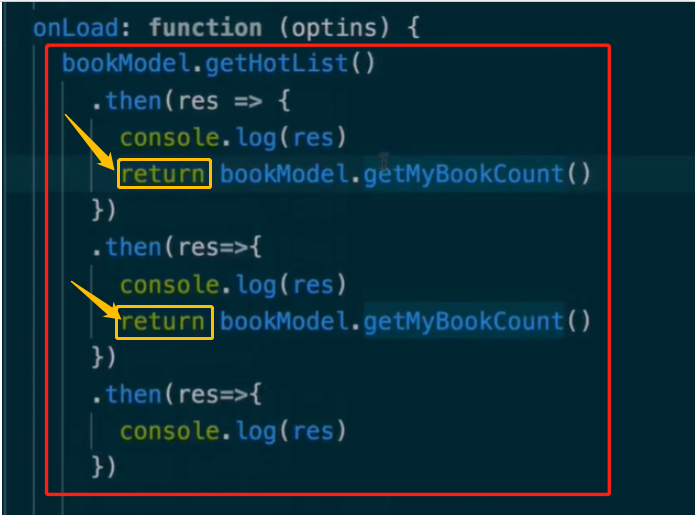1.success回调函数请求数据特点
需要随时传递回调函数(把回调函数当做参数传入函数中)

2.success回调函数请求数据---代码展示
2.1.在utils文件夹建立一个公共函数https.js

const commondata = getApp() let statusCode = { '1': "网络出错", "301": "永久重定向", "401": "登录出错", "403": "被禁止访问", "404": "找不到", "405": "错误请求方法", "409": "冲突", "413": "上传文件太大", "500": "服务器错误" } // HTTP类 request函数:HTTP类的方法(类下面的函数称为方法) class HTTP{ request(params){ if(!params.method){ params.method = "GET" } wx.request({ method: params.method, url: commondata.commonurl + params.url, data: params.data, header: { "content-type": "application/json", "appkey": commondata.appkey }, success: (res) => { let code = res.statusCode.toString() if( code.startsWith("2") ){ // 当状态码是2开头的情况 if(params.success){ params.success(res) } }else{ // 当状态码不是2开头的情况 this._showError(code) } }, fail: (err) => { // 当断网的情况下,走fail函数 this._showError("1") } }) } // 封装错误弹框类型 _showError(code){ wx.showToast({ "title": statusCode[code] ? statusCode[code] : statusCode[1], "icon": "error", "duration": 1500 }) } } export { HTTP }
2.2.再建立一个model模块,创建classic.js文件,在classic.js文件中调用http.js公共函数

import { HTTP } from "../utils/https"
class classModel extends HTTP {
getLatest(thecallback){
this.request({
url: "classic/latest",
success: (res) => {
thecallback(res)
}
})
}
gettheOthers(index, directions, thecallback){
this.request({
url: `classic/${index}/${directions}`,
success: (res) => {
thecallback(res)
}
})
}
getnewestBoolen(index){
return index == 8 ? true : false
}
getfirstBoolen(index){
return index == 1 ? true : false
}
_tosetNewestIndexStotrage(index){
wx.setStorageSync("newestIndex", index)
}
_togetNewestIndexStotrage(){
wx.getStorageSync("newestIndex")
}
_classicStroageIndex(index){
return "class_" + index
}
}
export { classModel }
2.3.在classic的page页面中调用model模块中的classic.js文件,具体实施请求数据的动作。


3.Promise对象请求数据---代码展示
3.1.在utils文件夹建立一个公共函数https-p.js

const commondata = getApp() let statusCode = { '1': "网络出错", "301": "永久重定向", "401": "登录出错", "403": "被禁止访问", "404": "找不到", "405": "错误请求方法", "409": "冲突", "413": "上传文件太大", "500": "服务器错误" } // HTTP类 request函数:HTTP类的方法(类下面的函数称为方法) class HTTP{ request({url, data={}, method="GET"}){ let thepromise = new Promise( (resolve, reject) => { this._request(url, resolve, reject, data, method) }) return thepromise } _request(url, resolve, reject, data={}, method="GET"){ wx.request({ method: method, url: commondata.commonurl + url, data: data, header: { "content-type": "application/json", "appkey": commondata.appkey }, success: (res) => { let code = res.statusCode.toString() if( code.startsWith("2") ){ // 当状态码是2开头的情况 resolve(res) }else{ reject() // 当状态码不是2开头的情况 this._showError(code) } }, fail: (err) => { reject() // 当断网的情况下,走fail函数 this._showError("1") } }) } // 封装错误弹框类型 _showError(code){ wx.showToast({ "title": statusCode[code] ? statusCode[code] : statusCode[1], "icon": "error", "duration": 1500 }) } } export { HTTP }
3.2.在model模块中,创建book.js文件,在book.js文件中调用http-p.js公共函数

import { HTTP } from "../utils/https-p.js"
class bookModel extends HTTP {
getHostList(){
return this.request({
url: "book"
})
}
}
export { bookModel }
3.3.在book的page页面中调用model模块中的book.js文件,具体实施请求数据的动作。


4.Promise对象解决了回调地域的缺陷
请求函数getHotList成功之后,需要在getHotList请求成功的前提下,再一次请求getMyBookCount。
请求函数getMyBookCount成功之后,需要在getMyBookCount请求成功的前提下,再一次请求getMyBookCount。
即,请求函数一环套一环,这就是俗称的“回调地域”。
用Promise对象后,可以通过以下的then的方式来很好的展示出来。

Tips:通过在then方法里面使用return来返回promise对象,然后就可以继续下一次请求函数时候再次的使用then方法。





 浙公网安备 33010602011771号
浙公网安备 33010602011771号